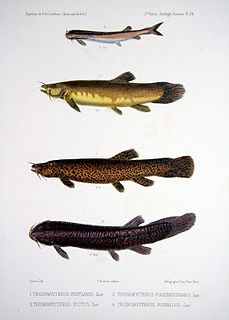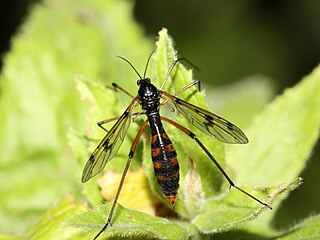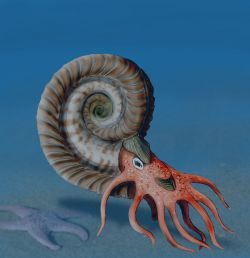
Trichomycteridae is a family of catfishes commonly known as pencil catfishes or parasitic catfishes. This family includes the candiru fish, feared by some people for its alleged habit of entering into the urethra of humans. They are one of the few parasitic chordates. Another species is the life monsefuano which was important to the Moche culture and still an important part of Peruvian cuisine.

The Cetopsidae are a small family of catfishes, commonly called the whale catfishes.

Psychodidae, called drain flies, sink flies, filter flies, sewer flies, or sewer gnats is a family of true flies. Some genera have short, hairy bodies and wings giving them a "furry" moth-like appearance, hence one of their common names, moth flies. Members of the sub-family Phlebotominae which are hematophagous may be called sand flies in some countries, although this term is also used for other unrelated flies.

Bittacidae is a family of scorpionflies commonly called hangingflies or hanging scorpionflies.

The Ptychopteridae, phantom crane flies, are a small family of nematocerous Diptera. Superficially similar in appearance to other "tipuloid" families, they lack the ocelli of the Trichoceridae, the five-branched radial vein of the Tanyderidae, and the two anal veins that reach the wing margins of the Tipulidae. They are usually allied with the Tanyderidae based on similarities of the mesonotal suture, this group being called the Ptychopteromorpha.
Yakounia is a genus of evolutely coiled, planispiral ammonite, coiled so all whorls are exposed, with close transverse ribbing. This genus lived during the Toarcian stage, late early Jurassic, and has been found in western British Columbia. The brief description is based on that of the subfamily.
The Glanapteryginae are a subfamily of catfishes of the family Trichomycteridae. It includes four genera, Glanapteryx, Listrura, Pygidianops, and Typhlobelus.
The Sarcoglanidinae are a subfamily of catfishes of the family Trichomycteridae. It includes six genera, Ammoglanis, Malacoglanis, Microcambeva, Sarcoglanis, Stauroglanis, and Stenolicmus.

Hauffiosaurus is an extinct genus of Early Jurassic pliosaurid plesiosaur known from Holzmaden of Germany and from Yorkshire of the United Kingdom. It was first named by Frank Robin O’Keefe in 2001 and the type species is Hauffiosaurus zanoni. In 2011, two additional species were assigned to this genus: H. longirostris and H. tomistomimus.

Coptoclavidae is an extinct family of aquatic beetles in the suborder Adephaga. The Coptoclavidae lived from the Triassic to the Early Cretaceous. Coptoclavidae is a clade of Dytiscoidea. The increase in the teleost fish population and the competition of Gyrinidae and Dytiscidae is believed to have caused their extinction.

Macrospondylus is an extinct genus of machimosaurid teleosauroid crocodyliform from the Early Jurassic (Toarcian) of Europe. Fossils are known from the Posidonia Shale of Germany, the Whitby Mudstone of the United Kingdom, and the "schistes bitumineux" of Luxembourg.

The family Dactylioceratidae comprises Early Jurassic ammonite genera with ribbed and commonly tuberculate shells that resembled later Middle Jurassic stephanoceratids and Upper Jurassic perisphinctids. Shells may be either evolute or involute.

Harpoceratinae is an extinct subfamily of cephalopods belonging to the family Hildoceratidae. Ammonites of this subfamily had involute and compressed shells with strong keels. Keel might be rarely missing, but this is considered to be an abnormality. This has been observed both in Cleviceras and Harpoceras and called as genus Monestieria, which is now known to be invalid. Another example is Pseudolioceras, whose unkeeled specimen was used as type for description of invalid genus Praehaploceras. Oxyconic forms of this subfamily does not have any keel. Ribs were single, but in some genera also bifurcating with shapes from sigmoidal to falcate. Sometimes, shell can have only striate ribs or is smooth. Tubercules are rare. Dimorphism is known in some genera and it is observable mostly in size. Macrochons can be 4, to 6 times larger than microconchs. As an example, macroconchs of Pseudolioceras are more than 150mm in diameter, while adult microconchs are only 35-50mm. There are big size differences even within dimorphs. Specimens ca be 2, or sometimes even 3 times bigger than other specimens of same dimorph.
Nodicoeloceras is genus of ammonite that lived during early to middle Toarcian stage of early Jurassic. Members of this genus existed from Exaratum Subzone of Falciferum Zone to Commune subzone of Bifrons Zone. Their fossils were found in Europe, northern Africa, Asia, North America and South America. It has probably evolved from Dactylioceras (Orthodactylites) or Kedonoceras and gave rise to Mesodactylites.
Mesodactylites, which is sometimes considered to be a synonym of Nodicoeloceras is genus of ammonite that lived during early to middle Toarcian stage of early Jurassic. Their fossils were found in southern and central Europe and northern Africa. It has evolved from Nodicoeloceras.

The subfamily Dactylioceratinae comprises early Jurassic ammonite genera that lived during Upper Pliensbachian to Upper Toarcian stage. These dactylioceratids existed from Margaritatus ammonite Zone, when they have evolved from Reynesocoeloceratinae and died out in Variabilis Zone without leaving any descendants.

Hildoceratinae is an extinct subfamily of cephalopods belonging to the family Hildoceratidae. Ammonites of this subfamily had shells with elliptical or quadrate whorl section with keel or tricarinate, bisulcate venter. Ribs were variable, from falcate to strongly angled and from fine to strong. They can be interrupted by spiral groove in midlateral part of the shell. While some species can be smooth, strongly ribbed ones can have tubercules. Microconchs have short lapplets that is in its shape similar to the shape of growth lines in spiral midlateral groove.
The Progonocimicidae are an extinct family of true bugs in the suborder Coleorrhyncha. Progonocimicidae fossils have been found in Europe, Asia, Australia, and South America.

The Marne di Monte Serrone is a geological formation in Italy, dating to roughly between 181 and 178 million years ago, and covering the early and middle Toarcian stage of the Jurassic Period of central Italy. It is the regional equivalent to the Toarcian units of Spain such as the Turmiel Formation, units in Montenegro, such as the Budoš Limestone and units like the Wazzant Formation and the Azilal Formation of Morocco.

Mercaticeras is an extinct genus of ammonites belonging to the family Hildoceratidae.













